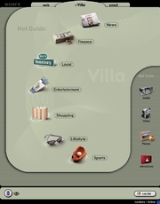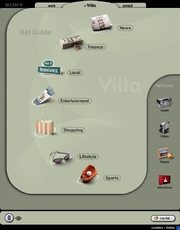
Sony eVilla
Encyclopedia
The Sony eVilla is a discontinued Internet appliance
from Sony
. After 18 months of development, it was released to the public on June 14, 2001 for $499 USD
. With the additional $21.95 USD monthly fee, users could access the Internet
, send and receive e-mail
, play audio and video, and save files to Sony's Memory Stick
.
After less than three months in the market, Sony discontinued the product on September 13, 2001. Customers received full refunds for the product and the monthly subscription fee. Spokesman John Dolak remarked that "[the] product did not meet our expectations, it did not operate as planned."
Sony entered the Internet appliance market as other manufacturers were getting out, canceling their plans, and discontinuing their offerings. By the time the Sony eVilla shipped, only 150,000 internet appliance devices had shipped within the past year. In addition, many customers could not justify the purchase of an inherently limited internet appliance when other manufacturers were offering more capable personal computers for the same price.
 The Sony eVilla was powered by a 266 MHz Geode
The Sony eVilla was powered by a 266 MHz Geode
GX 1 CPU
, with 64 MiB
DRAM
, and 24 MiB flash memory
. It weighed 31.5 pounds (14.3 kg) and measured 11.81 × 16.18 × 15.82 inches (30 × 41.1 x 40.2 cm).
There was no hard disk
, but the system could read and write to Sony's Memory Stick
cards. The included keyboard
and mouse
were connected by two PS/2 ports
, and additional devices could be connected with two USB
ports. A 56K V.90 modem
was built into the case, which also housed an unused Ethernet
port.
The display was a portrait-style 15 inch (38 cm) Sony Trinitron
, with 800×1024 pixel resolution.
The system used the BeIA
1.0 operating system
from Be Inc.
, and supported Java applications, Macromedia Flash animations, and some Microsoft Office
file formats. Also included was RealNetworks
's RealPlayer
.
One of the major drawbacks of the eVilla was the inability to save pictures and media from internet sites.
Internet appliance
An Internet appliance is a consumer device whose main function is easy access to Internet services such as WWW or e-mail. The term was popularized in the 1990s, when it somewhat overlapped in meaning with an information appliance, Internet computer, network computer, or even thin client, but now it...
from Sony
Sony
, commonly referred to as Sony, is a Japanese multinational conglomerate corporation headquartered in Minato, Tokyo, Japan and the world's fifth largest media conglomerate measured by revenues....
. After 18 months of development, it was released to the public on June 14, 2001 for $499 USD
United States dollar
The United States dollar , also referred to as the American dollar, is the official currency of the United States of America. It is divided into 100 smaller units called cents or pennies....
. With the additional $21.95 USD monthly fee, users could access the Internet
Internet
The Internet is a global system of interconnected computer networks that use the standard Internet protocol suite to serve billions of users worldwide...
, send and receive e-mail
E-mail
Electronic mail, commonly known as email or e-mail, is a method of exchanging digital messages from an author to one or more recipients. Modern email operates across the Internet or other computer networks. Some early email systems required that the author and the recipient both be online at the...
, play audio and video, and save files to Sony's Memory Stick
Memory Stick
Memory Stick is a removable flash memory card format, launched by Sony in October 1998, and is also used in general to describe the whole family of Memory Sticks...
.
After less than three months in the market, Sony discontinued the product on September 13, 2001. Customers received full refunds for the product and the monthly subscription fee. Spokesman John Dolak remarked that "[the] product did not meet our expectations, it did not operate as planned."
Sony entered the Internet appliance market as other manufacturers were getting out, canceling their plans, and discontinuing their offerings. By the time the Sony eVilla shipped, only 150,000 internet appliance devices had shipped within the past year. In addition, many customers could not justify the purchase of an inherently limited internet appliance when other manufacturers were offering more capable personal computers for the same price.
Hardware and Software

Geode (processor)
Geode is a series of x86-compatible system-on-a-chip microprocessors and I/O companions produced by AMD, targeted at the embedded computing market....
GX 1 CPU
Central processing unit
The central processing unit is the portion of a computer system that carries out the instructions of a computer program, to perform the basic arithmetical, logical, and input/output operations of the system. The CPU plays a role somewhat analogous to the brain in the computer. The term has been in...
, with 64 MiB
Mebibyte
The mebibyte is a multiple of the unit byte for digital information. The binary prefix mebi means 220, therefore 1 mebibyte is . The unit symbol for the mebibyte is MiB. The unit was established by the International Electrotechnical Commission in 2000 and has been accepted for use by all major...
DRAM
Dynamic random access memory
Dynamic random-access memory is a type of random-access memory that stores each bit of data in a separate capacitor within an integrated circuit. The capacitor can be either charged or discharged; these two states are taken to represent the two values of a bit, conventionally called 0 and 1...
, and 24 MiB flash memory
Flash memory
Flash memory is a non-volatile computer storage chip that can be electrically erased and reprogrammed. It was developed from EEPROM and must be erased in fairly large blocks before these can be rewritten with new data...
. It weighed 31.5 pounds (14.3 kg) and measured 11.81 × 16.18 × 15.82 inches (30 × 41.1 x 40.2 cm).
There was no hard disk
Hard disk
A hard disk drive is a non-volatile, random access digital magnetic data storage device. It features rotating rigid platters on a motor-driven spindle within a protective enclosure. Data is magnetically read from and written to the platter by read/write heads that float on a film of air above the...
, but the system could read and write to Sony's Memory Stick
Memory Stick
Memory Stick is a removable flash memory card format, launched by Sony in October 1998, and is also used in general to describe the whole family of Memory Sticks...
cards. The included keyboard
Computer keyboard
In computing, a keyboard is a typewriter-style keyboard, which uses an arrangement of buttons or keys, to act as mechanical levers or electronic switches...
and mouse
Mouse (computing)
In computing, a mouse is a pointing device that functions by detecting two-dimensional motion relative to its supporting surface. Physically, a mouse consists of an object held under one of the user's hands, with one or more buttons...
were connected by two PS/2 ports
DIN connector
A DIN connector is a connector that was originally standardized by the , the German national standards organization. There are DIN standards for a large number of different connectors, therefore the term "DIN connector" alone does not unambiguously identify any particular type of connector unless...
, and additional devices could be connected with two USB
Universal Serial Bus
USB is an industry standard developed in the mid-1990s that defines the cables, connectors and protocols used in a bus for connection, communication and power supply between computers and electronic devices....
ports. A 56K V.90 modem
Modem
A modem is a device that modulates an analog carrier signal to encode digital information, and also demodulates such a carrier signal to decode the transmitted information. The goal is to produce a signal that can be transmitted easily and decoded to reproduce the original digital data...
was built into the case, which also housed an unused Ethernet
Ethernet
Ethernet is a family of computer networking technologies for local area networks commercially introduced in 1980. Standardized in IEEE 802.3, Ethernet has largely replaced competing wired LAN technologies....
port.
The display was a portrait-style 15 inch (38 cm) Sony Trinitron
Trinitron
Trinitron is Sony's brand name for its line of aperture grille based CRTs used in television sets and computer display monitors. One of the first truly new television systems to enter the market since the 1950s, the Trinitron was announced in 1966 to wide acclaim for its bright images, about 25%...
, with 800×1024 pixel resolution.
The system used the BeIA
BeIA
BeIA, or BeOS for Internet Appliances, was a minimized version of Be Inc.'s BeOS operating system for embedded systems.The BeIA system presents a browser based interface to the user. The browser was based on the Opera 4.0 code base, and was named Wanger...
1.0 operating system
Operating system
An operating system is a set of programs that manage computer hardware resources and provide common services for application software. The operating system is the most important type of system software in a computer system...
from Be Inc.
Be Inc.
Be Incorporated was an American computer company founded in 1990, best known for the Be Operating System and BeBox personal computer. Be was founded by former Apple Computer executive Jean-Louis Gassée with capital from Seymour Cray....
, and supported Java applications, Macromedia Flash animations, and some Microsoft Office
Microsoft Office
Microsoft Office is a non-free commercial office suite of inter-related desktop applications, servers and services for the Microsoft Windows and Mac OS X operating systems, introduced by Microsoft in August 1, 1989. Initially a marketing term for a bundled set of applications, the first version of...
file formats. Also included was RealNetworks
RealNetworks
RealNetworks, Inc. is a provider of Internet media delivery software and services based in Downtown Seattle, Washington, United States. The company is the creator of RealAudio, a compressed audio format; RealVideo, a compressed video format; RealPlayer, a media player; RealDownloader, a download...
's RealPlayer
RealPlayer
RealPlayer is a cross-platform media player by RealNetworks that plays a number of multimedia formats including MP3, MPEG-4, QuickTime, Windows Media, and multiple versions of proprietary RealAudio and RealVideo formats.-History:...
.
One of the major drawbacks of the eVilla was the inability to save pictures and media from internet sites.

